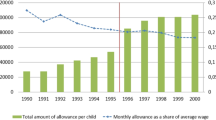Abstract
Little information is presently available about health issues associated with intercountry adoptions. This research starts to fill this gap by surveying the health problems of 200 children from India adopted by 166 Oregon families during the period 1978–1987. Parents' responses to a mail questionnaire revealed that at least 37.5% of the children were premature. The children's birth weights and birth lengths were 3 to 4 SDs below WHO norms, and almost all the children's weights and heights by age, at time of arrival in the United States were below WHO's 50th percentile value. Feeding problems were frequent (35.0%), as were salmonella (30.5%), malnutrition (22.0%), anemia (18.5%), and developmental delays (18.0%). Many children were not tested for communicable diseases endemic to India such as hepatitis B, tuberculosis and salmonellosis. Many diseases and health problems were unanticipated by parents on the basis of medical reports received from India, and parents expressed a need for greater support and better resources in dealing with these health problems.
Similar content being viewed by others
References
Bonham GS: Who adopts: The relationship of adoption and social demographic characteristics of women.J. Mar Fam 39:295–308, 1977.
Jenista JA, Chapman D: Medical problems of foreign-born adopted children.Amer J Dis Children 141:298–302, 1987.
Simon RJ, Altstein H:Transracial Adoption: A Follow-up. Lexington, MA: Health & CO., 1981. Pp. 93–103.
McRoy RG, Zurcher, LA:Transracial and Inracial Adoptees. Springfield, IL: Charles C. Thomas, 1983. Pp. 4–8.
International Concerns Committee for Children:Report on Foreign Adoption. Boulder, CO: Author, 1986, Pp. 1, 14, 15.
Nelson-Erichsen J, Erichsen HR: Gamines:How to Adopt from Latin America. Minneapolis, MN: Dillon Press, 1981. Pp. 160–207.
Martin CD:Beating the Adoption Game. LaJolla, CA: Oak Tree Publications, 1980. Pp. 154–172.
Plumez JH:Successful Adoption: A Guide to Finding a Child and Raising a Family. New York: Harmony Books, 1982. Pp. 90–94.
Weil, RH: International adoptions: The quiet migration.International Migration Rev 18:276–293, 1984.
Winick M, Meyer KK, Harris RC: Malnutrition and environmental enrichment by early adoption.Science 190(4220): 1173–1175, 1975.
Chandrasekhar S:Infant Mortality, Population and Family Planning in India. Chapel Hill, NC: University of North Carolina Press, 1972. Pp. 205–6.
United States Department of Justice, Immigration and Naturalization Service:1983 Statistical Yearbook of Immigration and Naturalization Service. Washington, DC: GPO, 1983. P.31.
Vestlie D (ed):The heart connection: The newsletter of the International Mission of Hope, Fall 1985. (Available from IMH Communications Center, PO Box 38909, Denver CO: 80238).
Clark-Prakash C: Bringing hope to abandoned children.International Mission of Hope 1986 desk calendar. (Available from Communications Center, PO Box 38909, Denver CO: 80238).
Johnson DE: “Dear Doctor,” letter to physicians caring for IMH children. University of Minnesota Dept of Pediatrics, No date.
Von Gilden-Wicker H, Haavig JW:Today's Child: Health Care Needs of IMH infants. Minneapolis, MN: Today's Child Publication, 1981.
Bolles EB:The Penguin Adoption Handbook: A Guide to Creating your New Family. New York: Penguin Books, 1984. Pp. 111, 117.
World Health Organization:A Growth Chart for International Use in Maternal and Child Health Care: Guidelines for Primary Health Care Personnel. Geneva: WHO, 1978. P.35.
Food Specialties Limited:Baby's Weight & Health Chart. M-54 Connaught Circus, New Delhi 100 001, India.
World Health Organization:The Growth Chart: A Tool for Use in Infant and Child Health Care. Geneva: WHO, 1986.
Bisen N:Child Rearing Practices in India. 1986. P.I. (Pamphlet available from Holt, P.O.Box 2880, Eugene, OR 97402).
Additional information
Tara Smith-Garcia is a Nurse Consultant, 808 North Yakima, Tacoma, Washington, 98403. Julia S. Brown is Professor of Sociology in Nursing, School of Nursing, Oregon Health Sciences University, 3181 S.W. Sam Jackson Park Road, Portland, Oregon, 97201.
This research was conducted in the Community Health Care Systems Department, School of Nursing, The Oregon Health Sciences University, Portland, Oregon. It was supported in part by a traineeship from the United States Government Health Service Grant Numbers 2 All and NU00250-09. The authors express their gratitude to Delores Lauber, Asian Coordinator for PLAN, for her unfailing cooperation and good will throughout the research, to Ann Scott of PLAN and Cherie Clark-Prakash of the International Mission of Hope for their kind support, and to Lydia Metje for assistance in transcribing data for analysis.
Rights and permissions
About this article
Cite this article
Smith-Garcia, T., Brown, J.S. The health of children adopted from India. J Community Health 14, 227–241 (1989). https://doi.org/10.1007/BF01338874
Issue Date:
DOI: https://doi.org/10.1007/BF01338874




